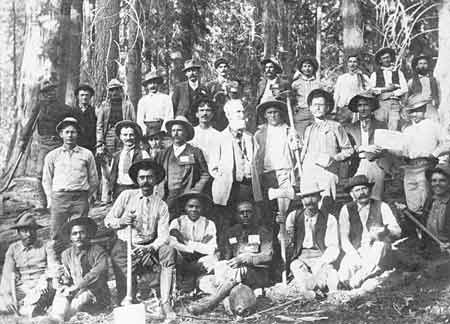
Six days after escorting President Roosevelt, Captain Young led Troops I and M on a 323-mile road march from the Presidio to Sequoia National Park. The journey across the state took sixteen days of serious horseback riding averaging over twenty miles a day. Since 1891 the U.S. Cavalry had provided troops to manage and protect California's national parks each summer. With the prior movement of Troops K and L to Yosemite National Park, and now the movement of Troops I and M to Sequoia National Park, 1903 was the first time African American soldiers were given the responsibility of park patrol for an entire summer season. Previously in 1899, the 24th Infantry patrolled Yosemite. 
The red dots indicate places they camped along the way. NPS On June 3rd, M and I troops arrived at Three Rivers (Kaweah). As the senior officer present, Captain Young achieved another first for a Black officer, being appointed as "Acting Superintendent" of Sequoia and the smaller adjacent General Grant National Park (later renamed Kings Canyon). Young immediately set his troops to work establishing a general supply camp. Detachments were sent to Cedar Creek, Cold Spring, Clough's Cave, and General Grant to begin patrols. Their mission was the same as that of Troops K and L at Yosemite, to "enforce the rules and regulations of the Department of the Interior" and to secure the Park from "injury and depredations." (31) Fire watches were established. The use of firearms was restricted and the regulation strictly enforced. After their required "annual target practice" the soldiers boxed and put away their carbines, only carrying them on patrols passing outside park boundaries. Captain Young quickly sent a detachment to the foot of Mount Whitney, (32) where their patrols prevented herders and their sheep from entering the meadows. As a result, tourists en route to the high country found plenty of grass for their animals to graze. (33) The 9th Cavalry also constructed, repaired, and improved the parks' roads and trails. Beginning in June, Captain Young put his men hard to work. Progress was rapid despite the rough and rocky terrain. In a job that required both skill and hard labor, forty to fifty men and up to twelve horses labored through the season to construct more miles of road than in the past three seasons combined. (34) Over one hundred years later the road that Captain Young's men helped build is still used as a Sequoia National Park hiking trail. 
As Acting Superintendent, Captain Young participated in social functions involving tourists, Sierra Club members, a congressional visit, and a great feast for his soldiers and the many others who had taken part in the summer's construction work. He also invited guests from the Army, Southern Pacific Railroad, and several leading citizens from the nearby city of Visalia. The party was a great success. The following year, national park duty in California would be carried out by another squadron of the 9th Cavalry, Troops A, B, C, and D, who were stationed at the Presidio of Monterey. For these tough, hardened veterans of the Indian Wars, the war with Spain, and the Philippine War, national park duty must have seemed a pleasant break. Nevertheless, this was still a challenging assignment for Charles Young and the 9th Cavalry soldiers. It was physically hard work to patrol and protect the vast and rugged national park lands. Then there was the racial divide. Caucasian Americans were not used to or comfortable with taking orders from Black Americans during this era. This resistance made it challenging to enforce the law and supervise park work. < Return to Buffalo Soldiers Home
|
Last updated: February 9, 2022
